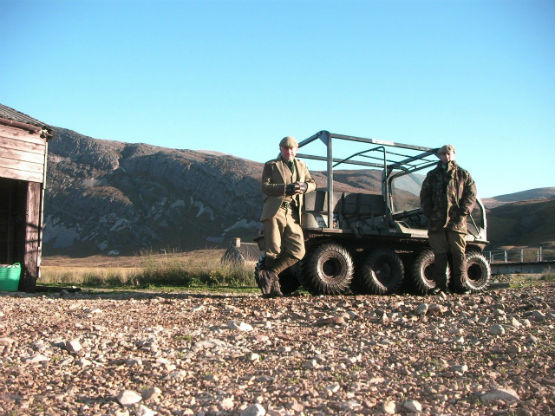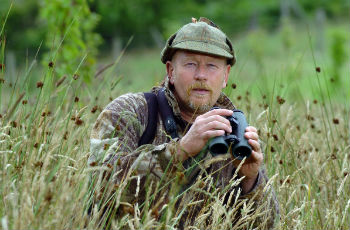Chris Dalton considers the arduous task of culling Red Hinds in the Scottish Highlands and why this type of work has traditionally been left to the professionals.

(Above: The stalking party make their way home by boat with a grand old lady well passed her best)
I have worked for a number of years now with a couple of highland estates assisting with the cull of Red Hinds. Now a lot of the hill estates do not let the hinds; there a number of reasons for this, not least of which is the often very physical and challenging nature of the terrain and, commonly, a large cull which has to be achieved in a short season, often made even shorter by adverse weather. There is also the unknown factor in terms of the ability and experience of paying guests and their level of fitness. On a clients first visit it can be very awkward to ask a guest, who may be paying a considerable sum, to muck in and drag a couple of hinds a mile or so to the Argo. Even if he or she is willing, they simply may not be physically able to do this, therefore the estates leave this task to their own experienced stalkers.
However, I find that this type of ground is great for me to get some folk through a DSC level 2. I know the individuals, they will have stalked with Tony or me before and we have assessed if they are fit enough and up to the task of walking all day and then shooting perhaps 3 or 4 hinds from a selected group and recovering them. I had done just this with Chris, a frequent guest of mine from Yorkshire, and he had completed his level 2 on this particular estate some years ago now and had enjoyed the experience of hill stalking and the spectacular views around Glenfinnan and so had asked to come back. So it was in late November last year, accompanied by his stalking buddy Martin and friend Shane that the return trip was made. Chris and Martin were to take a day about on the rifle during 5 days when we hoped to shoot around 12 hinds. Shane had come along to see what it was all about.
On Wednesday, having had a good 2 days and with 5 hinds in the larder, we were eating breakfast and looking out of the lodge at the dull conditions, very little wind and there had been a light frost, nothing too serious down at the loch side but higher up in the glens you never know – at least it was not raining or blowing too hard so we could get the boat out. At 8:30am on the dot, David the estate stalker arrived and we helped load the boat and shortly after we were powering up loch Shiel, very quickly making the 6 miles to Glenaladale. This is a pretty spectacular way to start your day and from the boat you can glass the surrounding hills as they descend to the loch shore, we spotted several small groups of hinds and you could feel the anticipation of the day and the eagerness of the guys to get out and onto the hill.

(Above: The Argo is now a common and crucial tool employed by Highland Stalkers)
David docks the boat in a small inlet close to a makeshift wooden jetty with practiced ease and we all manage the slightly tricky balancing act to get off the boat, pass off equipment and rifles etc and get onto dry land without a ducking, which is easier than it sounds but we negotiate it ok. From there it’s a short walk to a small shed at the mouth of the inlet and out comes the trusty Argo. Load up again and we make the journey in the Argo to the small emergency house where we get ready for the days stalk- it is all leg work from here on in.
The emergency house is an old, uninhabited property which has seen better days and sits at the bottom of the slopes of the glen, but it provides shelter and has some basic kit, food and the makings of a fire etc which are always kept ready just in case ! It has been required on numerous occasions due usually to either high winds preventing launching the boat or the weather really blowing in heavy snow! It’s comforting to know it is there. The guys are keen to be off but this is where experience tells and David settles and starts to glass all the surrounding hills, reconnaissance being the key. Now we are noting the weather conditions, in particular the wind; it’s a strong, cold northerly so we are paying special attention of the slopes where there is shelter or the sun is just starting to take some off the chill off and we can see a fair covering of snow on the high tops.
An initial quick scan reveals a few pockets of deer, both stags and hinds but then you start to glass slowly, looking deep into the slopes and you find more groups, we identify a possible small group of hinds and calves - they are in a location down wind and on a sheltered burn side which should allow us to get above them.
This would have been an ideal scenario for a DSC 2 candidate as I could now let them take over and make the approach, subsequent identification of suitable animals to fit the cull criteria and, hopefully, a successful shot followed by the gralloch and extraction. With luck it might even be possible to achieve two or even three of the witnessed stalks from this one group of hinds.
Anyhow, we were not witnessing this stalk, Chris who was on the rifle today could relax this was now stalk by committee! We had a little debate about the best approach, not always helpful as we all have different ideas; the sensible folk listen to David! However final plan made Chris followed a burn that kept us out of sight of any deer and quickly gained height from sea level to around 1500 feet which took around an hour. But at this level came the bitterly cold wind and driving snow that made glassing impossible; at one point we had to stand with our backs to the snow and sit it out as visibility dropped to zero.
As the weather cleared a bit, we decided to drop down the opposite side of the Glen to slightly lower slopes and certainly more shelter; this is where experience told David the deer would be. Sure enough, after a long careful decent and with the snow easing we could again glass the lower Glen and just below us on a grassy plateau were a group of a dozen mixed hinds and calves. One hind was immediately selected, she had a shabby coat, no calf and real thin back end and saddle, a grand old lady who had long since passed her sell by date – she was unlikely to survive the winter.
What would have been an easy approach was made difficult, as is often the case, by a stag laid in between us and the hinds. He was surveying his patch, quietly ruminating exactly where we wanted to go. So main party left behind and Chris forward on his own and on his belly he slowly wormed his way under the stag using every bit of cover available until he reached a ledge about 150 yards above the hinds. This is great, I can sit and watch and note his approach and use of the cover, and I wished I had score cards to hold up, I think I would have scored a 9 – he made a half decent job of it !
We watched as the rifle was quietly slipped into position and one of his 6.5 x 55 140gr home loads slid ever so gently into the chamber, the hind was our side of the group, quietly grazing and after a brief pause she turned fully broadside; The thud and reaction indicated a good shot, the hind walked forward a few paces before collapsing dead. We waited for the watching deer to disperse, there was no other suitable beast in this group; all were good hinds with fit healthy calves. As we all stood up and walked down to join Chris as he gralloched the hind, the stag above us seemed oblivious to our presence and the commotion below, and continued to graze a while before slowly ambling off round the hill! It’s not early October now, I am sure they know!
Gralloch performed, on what was confirmed as a very old hind in really quite poor condition, her teeth were well worn a perfect beast to take off the hill, meanwhile David headed back to collect the Argo cat for extraction. We spent a moment taking in the breathtaking scenery and watched as a Golden Eagle drifted across us, circling the site of the gralloch, they soon learn to follow the stalkers as dinner will oft be served.
Now the hard work begins! And we drag the beast first up and then down the hill to a spot where David can get the Argo. It’s fairly easy though as we can take turns and by the time we get to the accessible part of the hill David is waiting, now all we have to do is get the hind, all of us plus equipment back on the boat without falling in!!
 Chris Dalton is a highly respected Deer Manager in Scotland and runs Ayrshire Stalking, to contact Chris Tel: 07710 871190
Chris Dalton is a highly respected Deer Manager in Scotland and runs Ayrshire Stalking, to contact Chris Tel: 07710 871190
For more on Deer Stalking in Scotland follow this link: outings-scotland
Alternatively to read more from Chris follow this link to his latest article: deer-a-predictably-unpredictable-species



















